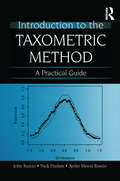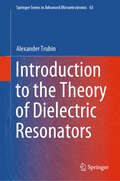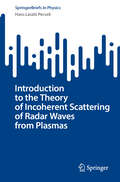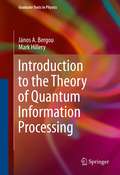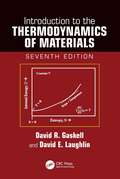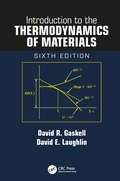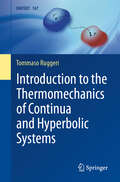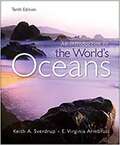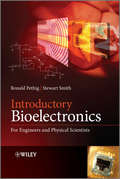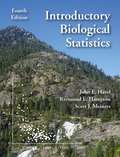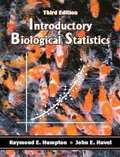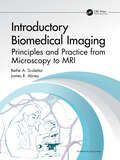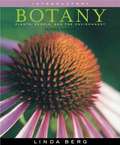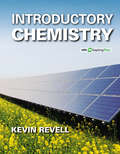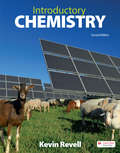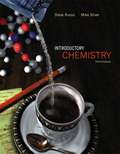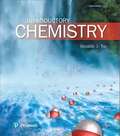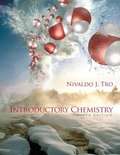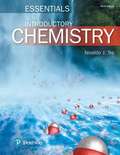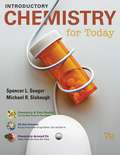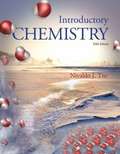- Table View
- List View
Introduction to the Taxometric Method: A Practical Guide
by Nick Haslam John Ruscio Ayelet Meron RuscioIntroduction to the Taxometric Method is a user-friendly, practical guide to taxometric research. Drawing from both classic and contemporary research, it provides a comprehensive introduction to the method. With helpful tools and guidance, the book is intended to teach those new to the method, as well as those already familiar with it, tips on how to conduct and evaluate taxometric investigations. The book covers a broad range of analytic techniques, describing their logic and implementation as well as what is known about their performance from systematic study. The book opens with the background material essential to understanding the research problems that the taxometric method addresses. The authors then explain the data requirements of taxometric analysis, the logic of each procedure, factors that can influence results and lead to misinterpretations, suggestions for choosing the best procedures, and methodological safeguards to prevent erroneous conclusions. Illustrative examples of each procedure and consistency test demonstrate how to perform analyses and interpret results using a variety of data sets. A checklist of conceptual and methodological issues that should be addressed in any investigation is included. The downloadable resources provide a variety of programs for performing taxometric analyses along with simulations and analyses of data sets. Introduction to the Taxometric Method is ideal for researchers and students conducting or evaluating taxometric studies in the social and behavioral sciences, especially those in clinical and personality psychology, as well as those in the physical sciences, education, biology, and beyond. The book also serves as a text for courses on this method, or as a supplement in psychological assessment, statistics, or research methods courses. Familiarity with taxometrics is not assumed.
Introduction to the Theory of Dielectric Resonators (Springer Series in Advanced Microelectronics #65)
by Alexander TrubinEmbark on a comprehensive exploration of high-Q dielectric resonators. The book covers various shapes, introducing innovative scattering theories and new perspectives on coupling coefficients. It breaks ground by investigating coupled oscillations in diverse resonator types, shapes, and dielectrics, extending to frequency-detuned resonators and lattice formations. The revolutionary S-matrix methodology is presented with practical applications, including complex structures like optical microcavities. The book concludes by delving into the time domain, exploring pulse scattering and radiation by antenna arrays of dielectric resonators. Primarily targeted at researchers, engineers, and students in electromagnetics, materials science, and physics. This work uniquely combines theoretical depth with practical applications in high-Q dielectric resonators.
Introduction to the Theory of Incoherent Scattering of Radar Waves from Plasmas (SpringerBriefs in Physics)
by Hans László PécseliThis book introduces the theory behind the incoherent scattering of electromagnetic waves (radar waves) by free electrons—a key technique for studying critical parameters of the Earth&’s ionosphere. Starting with scattering by statistically independent electrons, including magnetized cases, the book progressively develops a comprehensive model. This framework is extended to include &‘dressed particles&’, accounting for long-range Coulomb interactions between charged particles. A consistent approach to incorporating particle collisions is presented, with an example of charge exchange interactions for illustration. Appendices provide essential background material, ensuring the content is accessible to readers. Based on lectures delivered at the University of Tromsø, Norway, this book is designed for Masters and PhD students. It assumes a basic understanding of electromagnetism and plasma physics, including plasma waves and electrostatic phenomena. Familiarity with kinetic plasma theory and the collisionless Vlasov equation is beneficial but not mandatory.
Introduction to the Theory of Quantum Information Processing
by Mark Hillery János A. BergouIntroduction to the Theory of Quantum Information Processing provides the material for a one-semester graduate level course on quantum information theory and quantum computing for students who have had a one-year graduate course in quantum mechanics. Many standard subjects are treated, such as density matrices, entanglement, quantum maps, quantum cryptography, and quantum codes. Also included are discussions of quantum machines and quantum walks. In addition, the book provides detailed treatments of several underlying fundamental principles of quantum theory, such as quantum measurements, the no-cloning and no-signaling theorems, and their consequences. Problems of various levels of difficulty supplement the text, with the most challenging problems bringing the reader to the forefront of active research. This book provides a compact introduction to the fascinating and rapidly evolving interdisciplinary field of quantum information theory, and it prepares the reader for doing active research in this area.
Introduction to the Theory of Soft Matter
by Jonathan V. SelingerThis book presents the theory of soft matter to students at the advanced undergraduate or beginning graduate level. It provides a basic introduction to theoretical physics as applied to soft matter, explaining the concepts of symmetry, broken symmetry, and order parameters; phases and phase transitions; mean-field theory; and the mathematics of variational calculus and tensors. It is written in an informal, conversational style, which is accessible to students from a diverse range of backgrounds. The book begins with a simple "toy model" to demonstrate the physical significance of free energy. It then introduces two standard theories of phase transitions--the Ising model for ferromagnetism and van der Waals theory of gases and liquids--and uses them to illustrate principles of statistical mechanics. From those examples, it moves on to discuss order, disorder, and broken symmetry in many states of matter, and to explain the theoretical methods that are used to model the phenomena. It concludes with a chapter on liquid crystals, which brings together all of these physical and mathematical concepts. The book is accompanied online by a set of "interactive figures"--some allow readers to change parameters and see what happens to a graph, some allow readers to rotate a plot or other graphics in 3D, and some do both. These interactive figures help students to develop their intuition for the physical meaning of equations. This book will prepare advanced undergraduate or early graduate students to go into more advanced theoretical studies. It will also equip students going into experimental soft matter science to be fully conversant with the theoretical aspects and have effective collaborations with theorists.
Introduction to the Thermodynamics of Materials
by David R. Gaskell David E. LaughlinMaintaining the substance that has made Introduction to the Thermodynamics of Materials a perennial bestseller for decades, the Seventh Edition is updated to reflect the broadening field of materials science and engineering. Chapters are updated and revised throughout to be more useful and logical for students. Features more than 60 new homework problems for the students, a listing of terms and concepts introduced, and a summary section Includes more on mathematical and graphical analysis of the various state functions utilized in classical thermodynamics Includes a more extensive discussion of the third law of thermodynamics Features a new appendix on exact differential equations and mathematical relationships, including all mathematical relations among differentials of homogeneous functions utilized in the text Written as the definitive introduction to the thermodynamic behavior of materials systems, this text presents the underlying thermodynamic principles of materials and their applications and continues to be the best undergraduate textbook in thermodynamics for materials science students. An updated solutions manual is also available for qualifying adopting professors.
Introduction to the Thermodynamics of Materials (6th Edition)
by David R. Gaskell David E. LaughlinMaintaining the substance that made Introduction to the Thermodynamic of Materials a perennial best seller for decades, this Sixth Edition is updated to reflect the broadening field of materials science and engineering. The new edition is reorganized into three major sections to align the book for practical coursework, with the first (Thermodynamic Principles) and second (Phase Equilibria) sections aimed at use in a one semester undergraduate course. The third section (Reactions and Transformations) can be used in other courses of the curriculum that deal with oxidation, energy, and phase transformations. The book is updated to include the role of work terms other than PV work (e.g., magnetic work) along with their attendant aspects of entropy, Maxwell equations, and the role of such applied fields on phase diagrams. There is also an increased emphasis on the thermodynamics of phase transformations and the Sixth Edition features an entirely new chapter 15 that links specific thermodynamic applications to the study of phase transformations. The book also features more than 50 new end of chapter problems and more than 50 new figures.
Introduction to the Thermomechanics of Continua and Hyperbolic Systems (UNITEXT #167)
by Tommaso RuggeriThe primary aim of this book is to present a unified treatment of the thermomechanics of continua using the axiomatic approach typical of rational mechanics. While many books on continuum mechanics focus on specific types of continuous bodies, such as deformable solid bodies or fluids, this book adopts a general perspective. It presents the mathematical structure of balance laws and constitutive equations as a cohesive whole, with special attention given to the modern theory of constitutive equations. Notable principles such as the principle of material indifference and the contemporary interpretation of the principle of entropy are emphasized. This book will be beneficial not only to engineering students but also to students from other scientific disciplines where aspects of continuum mechanics are studied. It provides an opportunity to view traditionally distinct topics in a broader, interconnected context. To ensure self-consistency, the first part of the book addresses issues related to linear algebra, with a particular focus on linear operators within finite-dimensional vector spaces. The book then offers a detailed exploration of finite deformations of continua, followed by an overview of kinematics. It characterizes the various forces that can exist in a continuum, introduces the stress tensor, and presents the balance laws in both Eulerian and Lagrangian forms. Next, the modern theory of constitutive equations is defined, emphasizing the role of the general principles of material indifference and entropy as criteria for selecting physically acceptable classes of constitutive equations. The resulting field equations are specialized for various cases, including thermoelasticity, Eulerian fluids, Fourier-Navier‒Stokes fluids, and rigid heat conductors. In the final part of the book, partial differential equations in continuum mechanics are discussed, with particular attention given to hyperbolic systems. The method of characteristics is introduced in both linear and nonlinear cases, and the need to expand the class of solutions by introducing weak solutions is discussed, with shock waves being a significant case. As an illustrative example of a weak solution, the Riemann problem is presented for the fluid dynamic model of vehicular traffic, where cars are initially stopped at a red light and then start moving when the light turns green.
Introduction to the World's Oceans
by Keith A. Sverdrup Virginia ArmbrustAn Introduction to the World's Oceans, Tenth Edition, is an introductory oceanography text intended for students without a background in mathematics, chemistry, physics, geology, or biology. It emphasizes the role of basic scientific principles in helping understand the processes that govern the ocean and the earth. <p><p> To keep the text as current as possible, the authors conduct their own research and examine other findings such as analyzing satellite data and large-scale oceanographic programs. From this vast amount of data, they select interesting, relevant, and understandable examples that illustrate contemporary principles of oceanography. <p><p> An Introduction to the World's Oceans places greater emphasis on the physical and geological aspects of the oceans than on the chemical and geochemical properties, because the latter disciplines require more specific background knowledge. An ecological approach helps integrate the biological chapters with other subjects. Students are encouraged to look at oceanography as a cohesive and united discipline rather than a collection of subjects gathered under a marine umbrella. <p><p> As with all previous editions, the authors continue to make each chapter stand as independently as possible, so that professors can assign chapters in the order that best suits their classrooms.
Introductory Bioelectronics
by Stewart Smith Ronald R. PethigBioelectronics is a rich field of research involving the application of electronics engineering principles to biology, medicine, and the health sciences. With its interdisciplinary nature, bioelectronics spans state-of-the-art research at the interface between the life sciences, engineering and physical sciences.Introductory Bioelectronics offers a concise overview of the field and teaches the fundamentals of biochemical, biophysical, electrical, and physiological concepts relevant to bioelectronics. It is the first book to bring together these various topics, and to explain the basic theory and practical applications at an introductory level.The authors describe and contextualise the science by examining recent research and commercial applications. They also cover the design methods and forms of instrumentation that are required in the application of bioelectronics technology. The result is a unique book with the following key features:an interdisciplinary approach, which develops theory through practical examples and clinical applications, and delivers the necessary biological knowledge from an electronic engineer's perspectivea problem section in each chapter that readers can use for self-assessment, with model answers given at the end of the book along with references to key scientific publicationsdiscussions of new developments in the bioelectronics and biosensors fields, such as microfluidic devices and nanotechnologySupplying the tools to succeed, this text is the best resource for engineering and physical sciences students in bioelectronics, biomedical engineering and micro/nano-engineering. Not only that, it is also a resource for researchers without formal training in biology, who are entering PhD programmes or working on industrial projects in these areas.
Introductory Biological Statistics
by Scott J. Meiners Raymond E. Hampton John E. HavelCourses such as statistics, which develop quantitative analytical skills, remain important preparation for careers in the sciences and graduate school. The book supports teaching a one-semester-long course in statistics with a focus on biological examples and applications. Students need not have any prior exposure to probability and statistics, although college algebra is recommended. The book has added concept checks in all of the chapters, as well as more definition boxes and examples. A number of substantive changes has been made in this new edition. The exercises in each chapter have now been sorted into two groups: practice exercises (with solutions in appendix B) and homework exercises (solutions available only to instructors).
Introductory Biological Statistics (3rd Edition)
by Raymond E. Hampton John E. HavelHampton and Havel's clear, approachable text has guided a generation of biology students through their first foray into statistics. The third edition continues to provide a thorough grounding in all essential methods of descriptive and inferential statistics, ideal for any student seeking a career in experimental sciences. Each chapter has been carefully updated and restructured to enhance understanding, better bridge the gaps between topics, and create a pragmatic approach to learning the many uses of statistics in biology. The authors complement their descriptions with an abundance of examples and exercises that illustrate how to choose and apply statistical procedures and interpret their results in real-world scenarios, allowing students to develop and test their understanding while building their confidence with the material. The third edition explores changing standards of technology and includes new boxed examples written by experts on computer-intensive resampling methods, multivariate analysis, and meta-analysis. Use of Minitab's outstanding statistical software (now included on the CD accompanying the book) is incorporated through the text.
Introductory Biomechanics
by C. Ross Ethier Craig A. SimmonsIntroductory Biomechanics is a new, integrated text written specifically for engineering students. It provides a broad overview of this important branch of the rapidly growing field of bioengineering. A wide selection of topics is presented, ranging from the mechanics of single cells to the dynamics of human movement. No prior biological knowledge is assumed and in each chapter, the relevant anatomy and physiology are first described. The biological system is then analyzed from a mechanical viewpoint by reducing it to its essential elements, using the laws of mechanics and then tying mechanical insights back to biological function. This integrated approach provides students with a deeper understanding of both the mechanics and the biology than from qualitative study alone. The text is supported by a wealth of illustrations, tables and examples, a large selection of suitable problems and hundreds of current references, making it an essential textbook for any biomechanics course. C. Ross Ethier is a professor of Mechanical and Industrial Engineering, the Canada Research Chair in Computational Mechanics, and the Director of the Institute of Biomaterials and Biomedical Engineering at the University of Toronto, with cross-appointment to the Department of Ophthalmology & Vision Sciences. His research focuses on biomechanical factors in glaucoma and blood flow and mass transfer in the large arteries. He has taught biomechanics for over ten years. Craig A. Simmons is the Canada Research Chair in Mechanobiology and an assistant professor of Mechanical and Industrial Engineering at the University of Toronto, with cross-appointments to the Institute of Biomaterials and Biomedical Engineering andthe Faculty of Dentistry. His research interests include cell and tissue biomechanics and cell mechanobiology, particularly as it relates to tissue engineering and heart valve disease.
Introductory Biomedical Imaging: Principles and Practice from Microscopy to MRI (Imaging in Medical Diagnosis and Therapy)
by Bethe A. Scalettar James R. AbneyImaging is everywhere. We use our eyes to see and cameras to take pictures. Scientists use microscopes and telescopes to peer into cells and out to space. Doctors use ultrasound, X-rays, radioisotopes, and MRI to look inside our bodies. If you are curious about imaging, open this textbook to learn the fundamentals. Imaging is a powerful tool in fundamental and applied scientific research and also plays a crucial role in medical diagnostics, treatment, and research. This undergraduate textbook introduces cutting-edge imaging techniques and the physics underlying them. Elementary concepts from electromagnetism, optics, and modern physics are used to explain prominent forms of light microscopy, as well as endoscopy, ultrasound, projection radiography and computed tomography, radionuclide imaging, and magnetic resonance imaging. This textbook also covers digital image processing and analysis. Theoretical principles are reinforced with illustrative homework problems, applications, activities, and experiments, and by emphasizing recurring themes, including the effects of resolution, contrast, and noise on image quality. Readers will learn imaging fundamentals, diagnostic capabilities, and strengths and weaknesses of techniques. This textbook had its genesis, and has been vetted, in a "Biomedical Imaging" course at Lewis & Clark College in Portland, OR, and is designed to facilitate the teaching of similar courses at other institutions. It is unique in its coverage of both optical microscopy and medical imaging at an intermediate level, and exceptional in its coverage of material at several levels of sophistication.
Introductory Botany: Plants, People, and the Environment
by Linda R. BergClear and engaging, Linda Berg's INTRODUCTORY BOTANY: PLANTS, PEOPLE, AND THE ENVIRONMENT helps you develop an appreciation of the diverse organisms we call plants, including their remarkable adaptations to the environment and their evolutionary and ecological relationships. Filled with fascinating feature boxes, intriguing chapter-opening stories, and other applied content, the text contains interesting and topical information that will pique your curiosity and help you succeed in your course. Berg shows you the many ways in which plants are fascinating in their own right, important for the existence of all life on Earth, and useful for humans in all aspects of our lives. INTRODUCTORY BOTANY: PLANTS, PEOPLE, AND THE ENVIRONMENT is beautifully and clearly illustrated and features a dynamic art program that helps you visualize even the most complex concepts.
Introductory Chemistry
by David W. BallDavid W. Ball of Cleveland State University brings his new survey of general chemistry text, Introductory Chemistry, to the market with a fresh theme that will be sure to hold student interest: "Chemistry is Everywhere." Introductory Chemistry is intended for a one-semester introductory or preparatory chemistry course.
Introductory Chemistry
by Kevin RevellBuilding a Foundation with an Integrated Learning Experience. At its core, Introductory Chemistry is the result of a unique author vision to develop a robust combination of text and digital resources that motivate and build student confidence while providing a foundation for their success. Kevin Revell knows and understands students today. His thoughtful narrative/video/interactive program works seamlessly to provide the most accessible and engaging set of resources for introductory chemistry available. The same author voice is mirrored in all print and digital content, allowing students flexibility and ensuring a fully supported learning experience--whether using a book or going completely digital! Building a Foundation for Retention and Success. Introductory Chemistry introduces students to chemistry with an exceptionally engaging writing style that not only promotes understanding but uses devices like storytelling and analogies to help students learn at a deeper level and retain concepts. Interactive activities and online tutorials offer students targeted, hands-on practice with the most difficult concepts in the course and provide a foundation for conceptual understanding and problem solving skills. Moving from comprehension to retention, students solidify their understanding of material to the point where they just "know it. " Building a Foundation. . . Your Way! Written and developed as a flexible print and digital resource, Introductory Chemistry is designed to serve as a teaching and learning tool to meet instructors and students where they are today and provide support and tools tailored to various learning and teaching styles. Introductory Chemistry comes with a full suite of traditional textbook and lecture resources to support a traditional lecture-based course, as well as resources that make the transition to a more active classroom easier for instructors interested in doing so. Instructors who already subscribe to active learning techniques will also find tools to complement their efforts. Students can choose to access the content in the learning environment that best fits their needs: the printed narrative and pedagogy, the eBook and interactive digital tools, the video lecture modules, or a combination.
Introductory Chemistry
by Kevin RevellIntroductory Chemistry creates light bulb moments for students and provides unrivaled support for instructors! Highly visual, interactive multimedia tools are an extension of Kevin Revell’s distinct author voice and help students develop critical problem solving skills and master foundational chemistry concepts necessary for success in chemistry.
Introductory Chemistry
by Steve Russo Michael E. SilverIntroductory Chemistry,Third Edition helps readers master the quantitative skills and conceptual understanding they need to gain a deep understanding of chemistry. Unlike other books on the market that emphasize rote memory of problem-solving algorithms, Introductory Chemistry takes a conceptual approach with the idea that focusing on the concepts behind chemical equations helps readers become more proficient problem solvers. What Is Chemistry?, The Numerical Side of Chemistry, The Evolution of Atomic Theory, The Modern Model of the Atom 1, Chemical Bonding and Nomenclature, The Shape of Molecules, Chemical Reactions, Stoichiometry and the Mole, The Transfer of Electrons from One Atom to Another in a Chemical Reaction Intermolecular Forces and the Phases of Matter, What If There Were No Intermolecular Forces?, The Ideal Gas Solutions, When Reactants Turn into Products, Chemical Equilibrium, Electrolytes, Acids, and Bases, Nuclear Chemistry, The Chemistry of Carbon, Synthetic and Biological Polymers. For all readers interested in introductory chemistry.
Introductory Chemistry
by Nivaldo J. TroBuilds 21st century and problem solving skills, preparing students for success Now in its 6th Edition, the best-selling Introductory Chemistry continues to encourage student interest by showing how chemistry manifests in students’ daily lives. Author Nivaldo Tro draws upon his classroom experience as an award-winning instructor to extend chemistry from the laboratory to the student’s world, capturing student attention with relevant applications and an engaging writing style. The text provides a superior teaching and learning experience, enabling deep conceptual understanding, fostering the development of problem-solving skills, and encouraging interest in chemistry with concrete examples. Extending chemistry from the lab to the student’s world, the text reveals that anyone can master chemistry. Refined to meet its purpose of teaching relevant skills, the 6th Edition includes new questions, data, and sections to help students build the 21st century skills necessary to succeed in introductory chemistry and beyond. Already a visual text, in this edition the art has been further refined and improved, making the visual impact sharper and more targeted to student learning. The new edition also includes new Conceptual Checkpoints, a widely embraced feature that emphasizes understanding rather than calculation, as well as a new category of end-of-chapter questions called Data Interpretation and Analysis, which present real data in real life situations and ask students to analyze and interpret that data.
Introductory Chemistry
by Nivaldo TroTo succeed in introductory chemistry, you need to develop your problem-solving skills—but you’ll also need to understand why these skills are important. Introductory Chemistry, Fourth Edition extends chemistry from the laboratory to your world, helping you learn chemistry by demonstrating how it is manifested in your daily life. Throughout, the Fourth Edition presents a new student-friendly, step-by-step problem-solving approach that adds four steps to worked examples (Sort, Strategize, Solve, and Check). This proven text continues to foster student success beyond the classroom with MasteringChemistry®, the most advanced online tutorial and assessment program available.
Introductory Chemistry Essentials
by Nivaldo TroNow in its 6th Edition, the best-selling Introductory Chemistry continues to encourage student interest by showing how chemistry manifests in students'' daily lives. Author Nivaldo Tro draws upon his classroom experience as an award-winning instructor to extend chemistry from the laboratory to the student''s world, capturing student attention with relevant applications and an engaging writing style. The text provides a superior teaching and learning experience, enabling deep conceptual understanding, fostering the development of problem-solving skills, and encouraging interest in chemistry with concrete examples. Extending chemistry from the lab to the student''s world, the text reveals that anyone can master chemistry. <p><p> Refined to meet its purpose of teaching relevant skills, the 6th Edition includes new questions, data, and sections to help students build the 21st century skills necessary to succeed in introductory chemistry and beyond. Already a visual text, in this edition the art has been further refined and improved, making the visual impact sharper and more targeted to student learning. The new edition also includes new Conceptual Checkpoints, a widely embraced feature that emphasizes understanding rather than calculation, as well as a new category of end-of-chapter questions called Data Interpretation and Analysis, which present real data in real life situations and ask students to analyze and interpret that data.
Introductory Chemistry for Today (7th Edition)
by Spencer L. Seager Michael R. SlabaughDistinguished by its superior allied health focus and integration of technology, Seager and Slabaugh's INTRODUCTORY CHEMISTRY FOR TODAY, Seventh Edition continues to meet students' needs through diverse applications, examples, boxes, and outstanding technology tools. Prompts throughout the new edition lead students to OWL (web-based learning system)--two unique online programs that extend the lessons of the text and help students study smarter. In addition to the many resources found in OWL, the book and website contain questions modeled after the Nursing School and Allied Health Entrance Exams. INTRODUCTORY CHEMISTRY FOR TODAY dispels students' inherent fear of chemistry and instills an appreciation for the role chemistry plays in our daily lives through a rich pedagogical structure and an accessible writing style with lucid explanations. In addition, the book provides greater support in both problem-solving and critical-thinking skills--the skills necessary for student success. By demonstrating the importance of chemistry concepts to students' future careers and by providing important career information online, the authors not only help students set goals but also help them focus on achieving them.
Introductory Chemistry, Fifth Edition
by Nivaldo J. TroIntroductory Chemistry is designed for a one-semester, college-level, introductory or preparatory chemistry course. Students taking this course need to develop problem-solving skills--but they also must see why these skills are important to them and to their world. Introductory Chemistry extends chemistry from the laboratory to the student's world. It motivates students to learn chemistry by demonstrating the role it plays in their daily lives.
Introductory Chemistry: A Foundation
by Steven S. Zumdahl Donald J. DeCosteThe Eighth Edition of Zumdahl and DeCoste's best-selling INTRODUCTORY CHEMISTRY: A FOUNDATION combines enhanced problem-solving structure with substantial pedagogy to enable students to become strong independent problem solvers in the introductory course and beyond. Capturing student interest through early coverage of chemical reactions, accessible explanations and visualizations, and an emphasis on everyday applications, the authors explain chemical concepts by starting with the basics, using symbols or diagrams, and conclude by encouraging students to test their own understanding of the solution. This step-by-step approach has already helped numerous students master chemical concepts and develop problem-solving skills. The focus on conceptual learning and motivating students by connecting chemical principles to real-life experiences in chapter-opening discussions and "Chemistry in Focus" boxes require students to think through the Example step-by-step rather than simply scan the written Example in the text as many students do.
